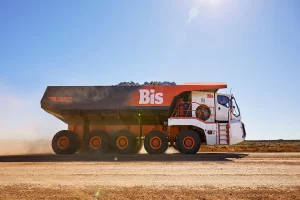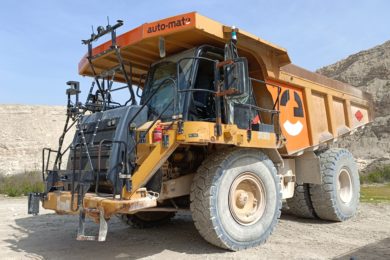The field of OEM-agnostic autonomous haulage technology providers for rigid mining trucks continues to strengthen with the latest entrant being Australia-headquartered Auto-mate, which has successfully completed trials of its autonomous solution on a 65 t payload (70 ton) Caterpillar 775 in Israel at a major quarrying operation. The trials, initially planned for Australia, were rescheduled after widespread travel restrictions were put in place at the start of the COVID-19 outbreak over two years ago. Auto-mate is a JV between innovative haulage, materials handling and automation group Bis Industries, and IAI (Israel Aerospace Industries).
IAI’s proven automation technology for operating in heavy off-road vehicles in remote and harsh environments has been in use since the early 2000s so starting Auto-mate’s system trials for mining there was seen an opportunity rather than a setback. The trials were designed to test a range of key scenarios all previously completed in a simulation environment. This included loading and dumping at predetermined locations, a range of haulage scenarios, obstacle and void detection, and performing load and dumping tasks. Where the autonomous vehicle detected an obstacle, it would slow down, assess the risk and, if safe, choose the optimal path around the obstacle or void. The engineering team currently running the trial in Israel is expected to arrive in Australia mid-year 2022 to further test Auto-mate’s solution at a site in Western Australia.
The autonomy system from Auto-mate is not only scalable and retrofittable, but is progressive, helping customers move from Level 3 conditional automation to Level 5 (full automation) – a stepping stone solution useful for smaller and mid-Tier mines that may want to prove the technology first. While the hardware is similar to other autonomous truck solutions namely radar, LiDAR, high resoution cameras – smart technology provides situational awareness and deep machine learning through the systems and sensors embedded on the vehicle – delivering truly smart vehicles rather than standard vehicles controlled by means of a smart control centre. Should communications be temporarily lost, the vehicle will keep operating in order to complete its mission, thus avoiding any loss of productivity or delays due to downtime. The open architecture of Auto-mate’s solution also allows it to integrate with existing systems and mixed fleets, lowering implementation costs and giving visibility across the fleet. The customer can use the data generated for forecasting and operational improvements.
Considerable interest has already been indicated by industry to see Auto-mate’s Cat 775 put through its paces in an operational environment. Auto-mate says it has progressed with the development of its autonomous solution in parallel for further applications in response to market interest. This includes application on the Bis Rexx hauler, the 160 t innovative mining truck with multiple steering and driving axles, enabling it to handle gradients of up to 12% when fully loaded. Rexx has already been widely trialled, including at Griffin Coal’s Ewington mine, Gold Fields’ Granny Smith mine and Glencore’s Murrin Murrin nickel operation, all in Western Australia.
IM spoke to Auto-mate’s Daniel Poller, CEO, and Damien Williams, Solutions and Implementation Manager to get more info on the Israel project and plans for the technology once it hits Australia

 Auto-mate CEO, Daniel Poller (left) and Solutions & Implementation Manager Damien Williams (right)
Auto-mate CEO, Daniel Poller (left) and Solutions & Implementation Manager Damien Williams (right)
Q Other OEM agnostic companies are also retrofitting automation to mining equipments; can you give a sense of the unique aspects of the Auto-mate system in terms of functionality and components?
Components we are keeping as common as possible and as more of us take on the challenge we welcome those components decreasing in cost as volumes increase. Functionally, we have the benefit of drawing on the experience of over 100 units deployed in an adjacent industry with commonality between applications such as off-road navigation, obstacle avoidance and ground engagement with material movement. In addition, our design methodology has come from one of scarcity: limited comms, limited consistency of operational area, limited restrictions on area entry. These all led to greater on-board decision making and analytics being developed so the asset could operate at Level 4 and above automation.
Q Why was the 775 chosen as the initial truck for retrofit? Is this the same model that would have been converted in WA if the project had not been delayed by the pandemic?
It was. The smaller size truck classes have been neglected from an automation standpoint as they were deemed non-viable commercially. Our lower price point automation turns this idea on its head and enables operations of all sizes to get healthy safety, operational and financial returns with automation. A 777 was also considered but the 775 platform was more readily available in Israel.
Q Do you have any agreements in place with mine operators or contractors to trial the system in Australia and when do you expect the first conversion to be complete in Australia?
We do. Unfortunately, they are all confidential at this stage however we can confirm we have two engagements underway with another two looking very likely to kick off in 2022.
Q Are there plans to fit the system to the Bis Rexx mining truck?
There are. We’ve had a number of genuine inquires on this and are considering delaying the Australian 775 for two to three months to fast track the automation of the Rexx for the middle of this year.
The multi-axle Bis Rexx truck is one of the next on the list to get Auto-mate’s innovative automation solution

Q Can you give some sense of how successful the Israel trial has been and is the customer now looking to install the system on multiple units?
It has gone incredibly well. We’ve learnt a lot and been able to get some great filming complete on the back of meeting our mining operational requirements. The quarry owner has now engaged with us to see if we can extend the trial and look at starting a deployment with them next year. This is the best endorsement in our opinion as they’ve seen the entire process warts and all and can see the value of the evolving offering.
Q How does your automation approach with AI enable a more flexible solution not tied to constant network infrastucture access?
We deploy our decision-making algorithms and AI onto the assets themselves which means that once a mission is loaded along with any operational parameters and restrictions, that asset is fully capable of making real-time, on board decisions to maximise safety and productivity. To meet Code of Practice requirements we have had to rein in the time our system will continue outside of comms but are excited to continue to push that boundary as we prove that enabling the machine is the safest approach. In those periods of communications outages the machine will continue on the mission with all sensors, parameters and controls operating normally. If an event or incident occurs at a site level that requires immediate site wide operations to cease then the automated machine will not receive that message until communications are restored. Given our systems will initially be deployed with a configurable out of comms period of between 0.5 and 2 seconds, we do not see this being a safety issue.
Q Can you expand on how your trucks can take corrective action themselves to obstacles or poor road conditions such as altering their route without input? Have you proven this?
This is core to our automation technology. The self-pathing and perception algorithms have been proven in over 100 assets in the defence industry and have now been proven in our trials on a mining asset. This ranges from the detection and avoidance of obstacles, the analysis and selection of optimum pathways on the road and identifying changing road conditions that go beyond the machine’s performance capabilities, such as road wash outs.










